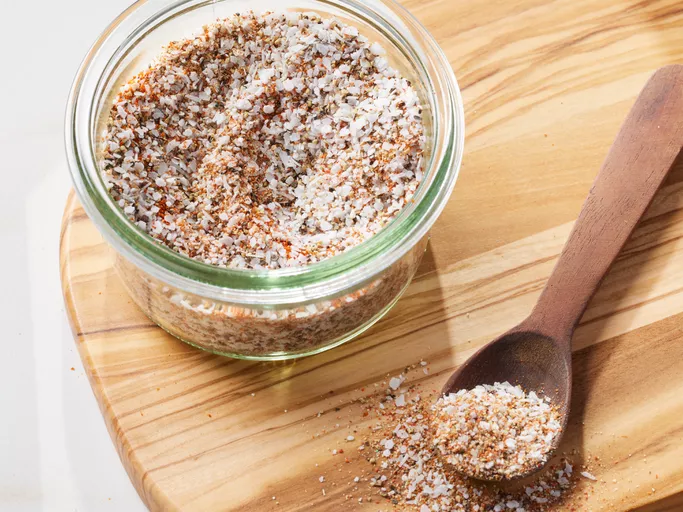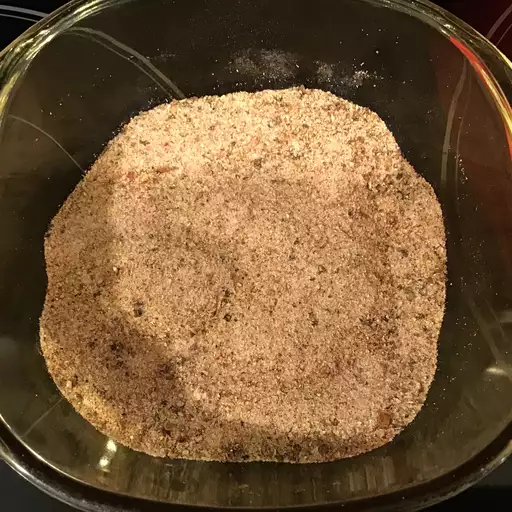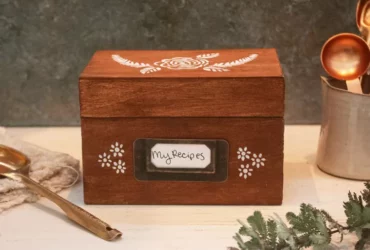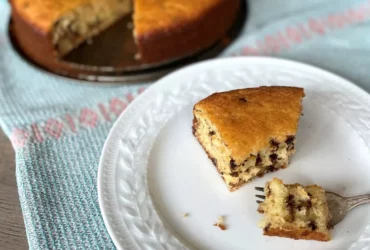Ingredients and Tools
Must-Have Ingredients
The art of crafting homemade seasoned salt lies in selecting the perfect blend of ingredients to create a truly unique flavor profile.
For this recipe, you’ll need the following must-have ingredients:
1 cup kosher salt
This type of salt is a staple for any seasoned salt blend due to its mild flavor and coarse texture. It provides an excellent base for your salt mix and helps to bring out the flavors of the other ingredients.
2 tablespoons dried herbs de Provence
A classic French herb blend featuring thyme, rosemary, oregano, and lavender, herbs de Provence adds a rich, savory flavor to your seasoned salt.
1 tablespoon garlic powder
Adding depth and warmth to your seasoning mix, garlic powder is a fundamental component in many recipes.
1 tablespoon onion powder
Similar to garlic powder, onion powder brings a sweet, caramelized flavor that enhances the overall taste of your seasoned salt.
1/2 teaspoon black pepper
A key element in seasoning blends, black pepper adds a sharp, pungent flavor that cuts through richness and balances out other flavors.
Salt-free seasonings (optional)
If you prefer to omit the kosher salt or use a different type of salt, you can substitute it with an equivalent amount of another salt-free seasoning, such as paprika or cayenne pepper, to maintain the overall balance of your recipe.
When selecting your ingredients, be sure to choose fresh and high-quality products for the best results. Old or stale herbs, spices, and seasonings can compromise the flavor of your homemade seasoned salt.
1 cup kosher salt
The primary ingredient in this recipe for homemade seasoned salt is kosher salt. Kosher salt has a coarser texture and a milder flavor than table salt, making it ideal for seasoning purposes.
To make the most of this recipe, it’s essential to have the right amount of kosher salt on hand. One cup of kosher salt will provide you with a generous supply of seasoned salt that can be used in a variety of dishes, from meats and vegetables to soups and sauces.
In addition to kosher salt, there are several other ingredients that can be added to create a unique blend of flavors. Some common additions include dried herbs such as thyme, oregano, or basil, which add depth and complexity to the seasoned salt.
Other options for flavor enhancers might include grated spices like garlic or onion powder, paprika, or cayenne pepper, which can add a touch of heat or smokiness to your dish.
The beauty of this recipe is that it allows you to customize the blend of flavors to suit your taste preferences. You can experiment with different combinations of herbs and spices to create unique flavor profiles for your seasoned salt.
2 tablespoons black peppercorns
The ingredients required for making homemade seasoned salt include a blend of various spices and seasonings that can vary based on personal preferences. For this recipe, we will focus on a basic mix that combines common flavor enhancers.
One key ingredient in this mixture is black peppercorns, which add a sharp, pungent taste to the salt. The amount needed can be adjusted according to individual taste preferences, but for a standard mix, about 2 tablespoons of black peppercorns are recommended.
In addition to black peppercorns, other ingredients that complement their flavor include dried herbs like thyme and rosemary, which add a savory depth. Garlic powder contributes an intense flavor without the overwhelming taste associated with fresh garlic. Paprika provides a smoky undertone while onion powder adds a sweet note.
2 tablespoons dried herbs (such as thyme, rosemary, or oregano)
To make a delicious homemade seasoned salt, you’ll need some essential ingredients and tools. Here’s what you’ll be using:
Main Ingredients:
- Dried herbs (such as thyme, rosemary, or oregano) – 2 tablespoons: These will add depth and warmth to your seasoned salt. You can use one type of herb or mix and match to create a unique flavor profile.
- Sea salt – 1/2 cup: This is the base of your seasoned salt, providing a crunchy texture and a touch of sweetness. Choose a high-quality sea salt for the best flavor.
- Granulated sugar – 1 tablespoon: A small amount of sugar helps balance out the savory flavors in your seasoned salt. You can adjust the amount to suit your taste preferences.
Optional Ingredients:
- Citrus zest (such as lemon or orange) – 1 teaspoon: Add a burst of citrus flavor to your seasoned salt with some grated zest.
- Smoked paprika – 1/2 teaspoon: Give your seasoned salt a smoky depth with this optional ingredient.
Tools:
Mortar and pestle
This traditional tool is perfect for grinding the ingredients together into a cohesive blend. You can also use a spice grinder or food processor, but be careful not to overprocess.
Measuring cups and spoons
Accurate measurements are crucial when making seasoned salt. Use digital or dry measuring cups and spoons to ensure you’re getting the right proportions.
Airtight container
Store your homemade seasoned salt in an airtight container to preserve its flavor and texture. You can also gift it in decorative containers for a thoughtful present.
1 tablespoon grated lemon zest
To make a delicious homemade seasoned salt recipe, you will need to gather the right ingredients and tools. Here’s what you’ll need:
Ingredients
- Lemon Zest: 1 tablespoon grated lemon zest adds a bright and citrusy flavor to your seasoning blend.
- Sea Salt: 1/4 cup flaky sea salt is the base of our seasoned salt recipe, providing a touch of crunch and a hint of saltiness.
- Paprika: 2 tablespoons smoked paprika adds a deep smoky flavor to your seasoning blend, perfect for grilled meats or vegetables.
- Ginger: 1 tablespoon grated fresh ginger adds an earthy and slightly spicy flavor to our seasoned salt recipe.
- Celery Salt: 2 tablespoons celery seed powder provides a subtle savory flavor, perfect for soups or stews.
- Black Pepper: 1 tablespoon freshly ground black pepper adds depth and warmth to your seasoning blend.
Tools
To mix and store our homemade seasoned salt recipe, you will need the following tools:
- A clean glass jar with a tight-fitting lid: This is where we’ll be storing our finished seasoned salt mixture. Choose a jar that’s airtight to keep your seasoning blend fresh.
- A spice grinder or mortar and pestle: If you have whole spices, you may need to grind them into smaller pieces using a spice grinder or mortar and pestle. This is also useful for freshly grinding the black pepper just before using it.
Instructions and Tips
The Blending Process
To create an authentic homemade seasoned salt recipe, it’s essential to understand the blending process involved in combining different ingredients. This process requires attention to detail and a clear understanding of how each component interacts with the others.
First and foremost, it’s crucial to choose high-quality ingredients for your seasoned salt blend. You can select from a variety of options such as sea salt, kosher salt, or Himalayan pink salt, depending on the desired flavor profile you want to achieve. The key is to select an ingredient that complements the other components in the blend.
Next, consider the types of seasonings you want to add to your mix. Popular options include paprika, garlic powder, onion powder, dried herbs such as thyme or oregano, and spices like cumin or coriander. The ratio of each ingredient will depend on personal taste preferences, so feel free to experiment with different combinations.
When it comes to the actual blending process, you can use a mortar and pestle, a spice grinder, or even a food processor to combine the ingredients. Be sure to blend in small batches to avoid over-processing, which can result in a loss of flavor and texture.
To achieve an evenly balanced mix, start by combining the dry ingredients first, then add any oils or other liquids as needed. If you’re using a spice grinder or food processor, be cautious not to over-process the mixture, as this can lead to a bitter taste.
One of the most critical steps in blending is adjusting the seasoning levels to your liking. This may require a series of trials and errors to perfect the ratio of ingredients. Remember, it’s always better to err on the side of caution and start with a smaller amount of each ingredient, gradually adding more as needed.
Finally, consider any additional steps you can take to enhance the flavor of your homemade seasoned salt blend. This might include adding a pinch of sugar or a splash of citrus juice to balance out the flavors or using different types of oil or vinegar to add depth and complexity.
The key takeaway is that creating an exceptional homemade seasoned salt recipe requires patience, experimentation, and attention to detail. By understanding the blending process and adjusting your seasoning levels accordingly, you can craft a custom blend that perfectly complements your favorite dishes.
Preheat oven to 350°F (175°C).
To get started with making your own homemade seasoned salt recipe, you’ll need to begin by preheating your oven to a specific temperature.
The first step in the process is to preheat your oven to 350°F (175°C). This is an important step as it will ensure that your seasoned salt blends evenly and properly when mixed with other ingredients later on.
Understanding Preheating
Preheating, or the act of warming up an appliance before using it, serves a few purposes. One of the most significant benefits is that it allows your oven to reach its optimal temperature more quickly. This helps prevent overheating and ensures that your seasoned salt is cooked evenly.
Additionally, preheating also plays a crucial role in activating certain enzymes within the ingredients used in your homemade seasoned salt recipe. Enzymes like those found in herbs and spices can become activated when exposed to heat, resulting in a more complex and intense flavor profile.
Tips for Preheating
Here are some tips to keep in mind when preheating your oven for making homemade seasoned salt:
Make sure to use a digital thermometer
A digital thermometer can provide you with an accurate reading of the temperature inside your oven. This is especially important if you’re new to baking or cooking.
Avoid overpreheating
It’s better to err on the side of caution and preheat your oven slowly, rather than risking overheating it too quickly.
Let it stand for a few minutes
After you’ve reached the desired temperature, let your oven stand for a few minutes before adding any ingredients. This will help ensure that your seasoned salt blends evenly and properly.
By following these simple steps and tips, you’ll be well on your way to creating delicious homemade seasoned salt recipes with ease.
In a small bowl, mix together kosher salt, black peppercorns, and dried herbs.
The art of creating a bespoke seasoned salt blend lies in carefully selecting and combining an array of aromatic ingredients to elevate the flavor profile of any dish. In this regard, kosher salt, with its distinctive flaky texture and mild flavor, serves as an excellent base for our homemade seasoned salt recipe.
To begin, combine 1/2 cup of kosher salt in a small bowl with 2 tablespoons of whole black peppercorns. The slightly sweet and nutty flavor of black peppercorns will add depth and warmth to the final product. Next, add 2 teaspoons of dried herbs such as thyme, rosemary, or oregano, depending on your personal preference. You can also experiment with other herbs like parsley, basil, or bay leaves to create a unique flavor profile.
Using a spoon, mix all the ingredients together until they are well combined and evenly distributed. Be sure to crush any large pieces of black peppercorns or dried herbs to release their flavors and oils. This will ensure that your seasoned salt blend is aromatic and fragrant.
Once you have completed the mixing process, transfer the seasoned salt blend to an airtight container, such as a glass jar with a tight-fitting lid. Store it in a cool, dark place to preserve its flavor and aroma. This homemade seasoned salt recipe will keep for several months when stored properly.
When using your homemade seasoned salt, simply sprinkle it over meats, vegetables, soups, or stews to add an extra layer of flavor. You can also use it as a finishing salt, sprinkling it over dishes just before serving to enhance their flavor and appearance.
In summary, creating a homemade seasoned salt recipe is a fun and rewarding process that allows you to experiment with various ingredients and flavors. By following this simple recipe and using high-quality ingredients, you can create a custom seasoned salt blend that adds depth and complexity to any dish.
Add the grated lemon zest and blend until well combined.
To make a homemade seasoned salt recipe, follow these instructions carefully to achieve a delicious and aromatic blend.
Gather the necessary ingredients and equipment:
- 1 cup kosher salt
- 2 tablespoons dried herbs (such as thyme, rosemary, or parsley)
- 1 tablespoon garlic powder
- 1 tablespoon onion powder
- 1/2 teaspoon black pepper
- Grated lemon zest (optional)
- Airtight container for storage
Now, let’s move on to the instructions:
- Mix together kosher salt, dried herbs, garlic powder, onion powder, and black pepper in a bowl until well combined.
- Add grated lemon zest (if using) to the bowl and blend until well combined.
- Transfer the seasoned salt mixture to an airtight container for storage.
Here are some tips to keep in mind:
- Use high-quality ingredients, such as freshly dried herbs, to ensure the best flavor.
- Adjust the amount of garlic and onion powder to your liking, or omit them altogether if you prefer a milder seasoning blend.
- Consider adding other seasonings or spices to create unique flavor variations, such as smoked paprika for a smoky twist or dried basil for an Italian-inspired taste.
- Store the seasoned salt in an airtight container at room temperature for up to 6 months. Shake the container before each use to redistribute the ingredients.
With these instructions and tips, you’re ready to create your own homemade seasoned salt recipe tailored to your taste preferences!
Tips for Use and Storage
Storing Your Seasoned Salt
To ensure that your homemade seasoned salt remains flavorful and potent, it’s essential to store it correctly.
Tips for Use
- Use a clean scoop or spoon to dispense the seasoned salt to prevent contamination.
- Avoid touching the rim of the container with your fingers to prevent transferring oils from your skin, which can cause clumping.
- For best flavor, use within a few months. Old seasoned salt may lose its potency and flavor over time.
Storing Your Seasoned Salt
To keep your homemade seasoned salt fresh for as long as possible:
- Air-tight containers: Store the seasoned salt in an airtight container, such as a glass jar with a tight-fitting lid.
- Dark location: Place the container in a dark location to protect it from light, which can cause degradation of flavor and color.
- Cool place: Store the container in a cool place, away from direct sunlight and heat sources.
You can also consider storing the seasoned salt in the fridge or freezer to prolong its shelf life. However, be sure to check on it periodically to ensure it remains usable.
Transfer your seasoned salt mixture to an airtight container.
To ensure that your homemade seasoned salt mixture stays fresh and flavorful, follow these tips for use and storage:
Transfer to an Airtight Container:
- Once you’ve made your seasoned salt mixture, transfer it to an airtight container as soon as possible.
- Use a clean glass jar with a tight-fitting lid or a plastic container with a secure seal.
- This will help prevent moisture and air from entering the container and affecting the flavor of your seasoned salt.
Store in a Cool, Dark Place:
- Store the container in a cool, dark place such as a pantry or cupboard.
- Avoid storing the container near heat sources, ovens, or stovetops, as this can cause the seasoning to degrade.
Keep it Dry:
- Maintain a low humidity environment by storing the container away from humid areas such as kitchens or bathrooms.
- Check the container regularly for signs of moisture or dampness, and transfer the seasoned salt to a new container if necessary.
Use Within Reasonable Timeframe:
- The shelf life of your homemade seasoned salt mixture depends on how well you store it, but in general, it will last for several months (up to 6-8 months).
- Use the seasoned salt within a reasonable timeframe to ensure optimal flavor and aroma.
Tips for Usage:
- When using your homemade seasoned salt mixture, start with a small amount and adjust to taste, as the flavors can be quite strong.
- Use it to season vegetables, meats, soups, and stews for added flavor and depth.
By following these tips, you’ll be able to enjoy your homemade seasoned salt mixture for a long time while maintaining its optimal flavor and aroma.
Store in a cool, dry place.
When it comes to using and storing homemade seasoned salt, there are several tips that can help you get the most out of this versatile seasoning blend.
First and foremost, store your homemade seasoned salt in a cool, dry place. This will help prevent the flavors from dissipating or becoming stale. Avoid storing it near heat sources, ovens, or stovetops, as the heat can cause the seasonings to break down and lose their potency.
Airtight containers are also essential for storing homemade seasoned salt. Transfer your seasoning blend to a clean glass jar with a tight-fitting lid, such as a mason jar or an airtight spice container. This will help keep air out and moisture in, preserving the flavor and aroma of your seasoned salt.
When it comes to using your homemade seasoned salt, be mindful of the amount you use. A little goes a long way with this seasoning blend, so start with a small pinch or sprinkle and adjust to taste. You can use it on vegetables, meats, soups, stews, and even baked goods.
One tip for using your homemade seasoned salt is to try different combinations of ingredients to create unique flavor profiles. For example, you could add some dried herbs like thyme or rosemary to give your seasoned salt a more herbaceous flavor, or try adding some smoked paprika for a smoky, savory taste.
Another tip is to use your homemade seasoned salt as a finishing salt, sprinkling it over dishes just before serving. This will help add a burst of flavor and aroma to your meals, without overpowering the other ingredients.
Finally, be sure to label your container with the date you made the seasoning blend, so you can keep track of how long it’s been stored and use the oldest batch first. This will ensure that your homemade seasoned salt stays fresh and flavorful for as long as possible.
- Best Lusha Alternatives for 2025 - April 22, 2025
- Best Overloop Alternatives for 2025 - April 22, 2025
- Best 6sense Alternatives for 2025 - April 22, 2025














